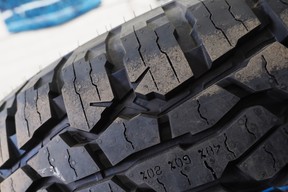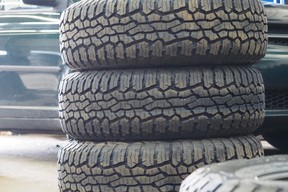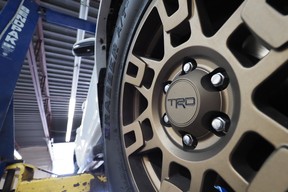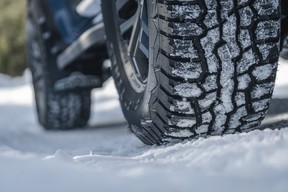Comparing traditional multi-ply tires to the latest aramid composite reinforcements.

Article content
If you live in Northern Ontario like me, there’s a good chance you drive a 4×4 like a Grand Cherokee, F-150, Wrangler, 4Runner, or ZR-2. In this part of Canada, vehicles like these are common picks for drivers who spend a lot of time on rough highways, backroads, and trails, often while towing a trailer a good distance from a sturdy cell signal.
Advertisement 2
Article content
The condition of the roads and trails these drivers will meet in the process can be hazardous to tires, especially during pothole season. After 17 years testing cars and tires in and around Sudbury, I’ve lost count of how many sidewalls I’ve had exploded by potholes, and how many rims they’ve turned to octagons — and that’s on the paved roads. The backroads and trails? Watch out.
Our tires take a lot of abuse from the terrain up here, and getting stranded after a blowout sucks because it’ll probably be somewhere remote, at 30 below, with a less-than-stellar chance of finding a cellular signal. It’s these sorts of reasons that push many motorists to seek out a tire upgrade, replacing factory-equipment rubber with something stronger and tougher for heavier duty. These upgrades mean one less thing to worry about when on the move in the bush.
My pal Nick Labrie is one of those drivers. He also recently became the owner of a new Toyota 4Runner, and also, a free set of Nokian Outpost AT tires that we’ll be testing together later on down the page.
Nick is a lucky guy. Did I mention he’s an auto service technician with years of experience selling tires to northern Ontario drivers? More on that later.
Advertisement 3
Article content
Nokian Tyres shipped over a set of their new Outpost AT tires so I could test them out and report back to readers. Below, I’ll use that experience to provide some comparison and impressions between the 2022 4Runner SR5’s factory-equipment Dunlop GrandTreks, as well as a set of 10-ply General Grabber ATXs that Labrie had installed as his first 4Runner upgrade.
We’ll illustrate the pros and cons of your various tire upgrade choices, and provide a few proven tires to check out along the way, if you’re starting a shopping list. The tires were provided to me (and ultimately Nick) free of charge, and as a multiple award-winning road safety journalist who’s made a living testing cars and tires for nearly 20 years, you’ll be hearing my unfiltered thoughts as always.
Advertisement 4
Article content
Anyways, Labrie’s 4Runner won’t have an easy life. It’s presently being geared up for a decade or more of off-road work towing, trailering, exploring, and visiting places you’d best hope you don’t blow a tire.
-
![Tips (and tires) for protection from potholes]()
Tips (and tires) for protection from potholes
-
![These tires use bulletproof vest tech to protect from pothole damage]()
These tires use bulletproof vest tech to protect from pothole damage
First, let’s learn about overkill.
“The 4Runner can’t even tow what these tires are rated for,” Labrie laughs. The 10-ply General Grabber ATX tires that he chose are basically a work truck tire and tremendous overkill for the application. Also, they deliver maximum strength and protection against tire related problems in the specific settings where this vehicle will be used.
Though he never recommends 10-ply tires to customers, they are used by drivers of specialty vehicles, or vehicles used commonly in extreme settings or very hard work. That added strength and support for big towing means they’re plenty strong enough for use in the bush.
Advertisement 5
Article content
“These tires were a want more than a need,” Labrie explains. “The average driver just isn’t willing to deal with the compromise of a 10-ply tire, and doesn’t need to”.
Much tougher and stronger than regular tires, 10-plies are pricier and typically noisier and less comfortable than regular tires. They’re heavier too, which reduces performance and fuel economy.

You almost definitely don’t need 10-ply tires on your truck or SUV, though some drivers accept the compromises for the right reasons, in exchange for the overkill-level confidence boost.
Somewhere between factory-equipment tires and 10-ply options are a wide range of toughened, strengthened, specialty tire options in between — including the new Outpost AT tires which recently joined Nokian’s lineup.
Advertisement 6
Article content
This reinforced and toughened-up all-terrain tire gives shoppers another confidence-boosting option for a factory tire upgrade, and for a lot of the same reasons.
Though not of a 10-ply construction, our Outpost AT test tires are built around special materials and construction including aramid, which reinforces and protects against road hazards and punctures.
I asked Steve Bourassa, Director of Products at Nokian Tyres, to explain the difference between a 10-ply tire, and a tire that’s been aramid reinforced.

“Tires with higher ply ratings are capable of higher inflation pressures than standard tires, up to 80 psi compared to around 50 psi for standard load tires” he said.
“This is needed for heavier loads in the truck bed or in towing applications to carry the commercial needs or recreational vehicles and trailers. While all of the Nokian Outpost tires include aramid, not all are 10-ply… However, Nokian Tyres does make some Outpost tires in 10-ply. Having one does not eliminate the need for the other, but having both offers great benefit for the consumer who needs both carrying capacity and strong durability.”
Advertisement 7
Article content
Have you heard of aramid? You can find its fibres in body armour, fishing-reel drag systems, and jet-engine enclosures. In the Outpost AT, they’re used like armour plating beneath the treads and sidewalls for increased mechanical strength against damage from potholes, rocks, and other road and trail hazards.
This reinforced-where-it-counts construction targets major improvements to wear resistance and durability: incidentally, the numbers-one and -two most important decision factors among pickup-tire shoppers, according to Nokian data. Further, four in ten pickup drivers will take their machine off-road, and grip and handling in winter conditions come in as the second most important set of purchase factors, at 46 percent of respondents (just behind wear resistance).
Advertisement 8
Article content
Importantly, these all rank above price and noise levels. That means confidence and peace of mind get pickup tire shoppers opening their wallets, and they aren’t afraid to dig in a little for a tire they trust.

We took the 4Runner for a ride on the 10-ply General Grabber ATXs to get some initial impressions.
I’ve spent thousands of kilometres testing various 4Runners on factory rubber, and my first experience on 10-ply tires made their compromises apparent.
The 4Runner is a popular sight up here, thanks in no small part to its delivery of good ride comfort on our badly beaten roads. On 10-ply tires, that’s knocked back a good measure. The 4Runner’s suspension does a nice job of keeping body motions smooth and consistent, though I noted a sharper ‘whack’ into bumps and cracks than I’m used to, as well as a more brittle feel to the ride over rough surfaces than I expect from this machine. The 10-ply rubber is tougher and stronger, but seems to rob our SR5 tester of the ‘soft-around-the-edges’ ride quality I’ve appreciated about the 4Runner for years. The same is true of noise levels. Though I’ve never noted the 4Runner for an exceptionally quiet drive on factory tires, the cabin noise levels on the 10-ply tires, both on smooth and coarsely textured surfaces, were much higher than I was expecting.
Advertisement 9
Article content
Next, we switched to the Outpost AT tires and repeated our test-ride, where I noticed two improvements right off the bat.

The same bumps and cracks that coaxed a brittle whack from the 4Runner’s ride on the 10-ply tires were now handled with more softness and less drama. The tires feel softer beneath you, meaning that the harsh initial impact of bumps and cracks is smoothed out.
The feel of the Outpost tires beneath the 4Runner benefit off-road ride comfort as well. The main takeaway is a softer and more compliant ride than the 10-ply rubber, and notably less harshness transmitted back to the passenger compartment. Even on rough and rocky surfaces, the Outpost ATs turned in a quieter, gentler, more laid-back off-road ride, arguably making them a better fit for the 4Runner’s capable but relaxed character in an off-road setting.
Advertisement 10
Article content
After a few days of driving, Labrie had spotted the key benefit of the switch: fuel economy.
“I’m averaging about a 1.5 L/100 km improvement on the Nokians, and I could see it right off the bat,” Labrie explains. Ditching the heavier 10-ply rubber drops the fuel consumption considerably, saving about $3.20 in gas per 100 kilometres driven in this case. That’s a few hundred bucks worth of fuel a year for most drivers.
“They balanced up nicely, too,” Labrie commented after installing the new Nokians. He also likes their look on his 4Runner.
“Enthusiasts appreciate a good looking tire, I love a good looking tire, and these tires hit the mark. I’m a big fan of the sharp patterning and definition on the sidewall, it’s way less boring-looking,” he says.
Advertisement 11
Article content

Though Sudbury hasn’t had much snow yet this year, Labrie says his main impression of the Outpost AT rubber on some initial snowfalls was a notable improvement in hard-stop performance versus the 10-ply General Grabber ATXs previously installed.
To recap, if you’re looking for an upgrade from factory-equipment tires for your truck or SUV, you could consider a 10-ply tire for frequent severe driving, but you’ll likely experience reduced fuel economy and a louder, less comfortable drive. Delivering a similar confidence boost with less of the compromise, the Nokian Outpost AT make a compelling choice when you’re after a major confidence boost.
According to Labrie, his customers in Sudbury have two go-to tires when it’s time for an upgrade: General Grabber ATX, and Toyo Open Country, with Hercules TerraTrac coming in as a popular lower-cost option.
Advertisement 12
Article content
“Our customers seem happy with these tires, and commonly buy them again” he says.

In Sudbury, we see that same brand loyalty in Nokian’s winter tires, the Hakapeliittas. Nicknamed ‘Hakkas’, they’re practically everyone’s favourite. With the Outpost AT, you can bet Nokian is looking to find some of that brand loyalty in the all-terrain and off-road world.
“I’ve been impressed so far,” Labrie commented after a three-month initial drive on the Outpost ATs that stretched into November. “I’d definitely recommend these to customers as well.”
It’s always nice to have choices, and to fully understand those choices before heading into your favourite locally owned tire retailer to discuss your options with an expert like Labrie.
Stay connected with us on social media platform for instant update click here to join our Twitter, & Facebook
We are now on Telegram. Click here to join our channel (@TechiUpdate) and stay updated with the latest Technology headlines.
For all the latest Automobiles News Click Here



